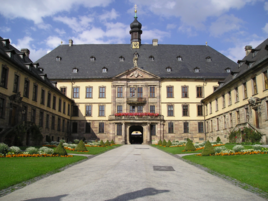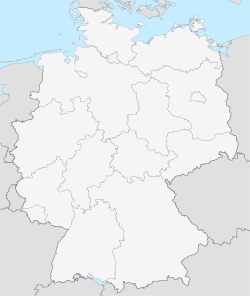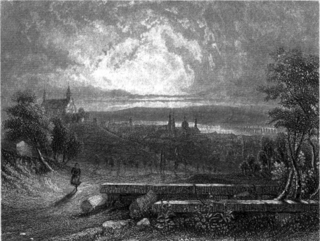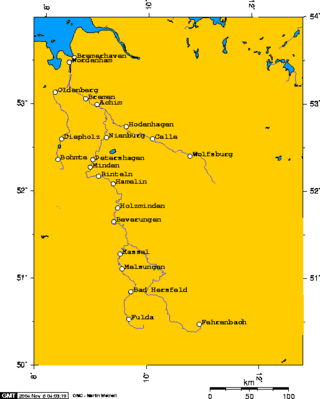Fulda
| Fulda | |
 |
|
| Coat of arms | Location |
 |
 |
| Administration | |
| Country | Germany |
|---|---|
| State | Hesse |
| Admin. region | Kassel |
| District | Fulda |
| Lord Mayor | Gerhard Möller (CDU) |
| Basic statistics | |
| Area | 104.04 km² (40.2 sq mi) |
| Elevation | 261 m (856 ft) |
| Population | 63,958 (30/12/2005) |
| - Density | 615 /km² (1,592 /sq mi) |
| Founded | 744 |
| Other information | |
| Time zone | CET/CEST (UTC+1/+2) |
| Licence plate | FD |
| Postal codes | 36001–36043 |
| Area code | 0661 |
| Website | www.fulda.de |
Fulda (IPA: [ˈfʊlda]) is a city in Hesse, Germany; it is located on the Fulda River and is the administrative seat of the Fulda district (Kreis).
Contents |
History
Early Middle Ages
The Benedictine monastery of Fulda was founded in 744 by Saint Sturm, a disciple of Saint Boniface, as one of Boniface's outposts in the reorganization of the church in Germany, and a base from which missionaries accompanied Charlemagne's armies in their political and military campaign to destroy heathen Saxony.
The initial grant for the abbey was signed by Carloman, the son of Charles Martel. The support of the Mayors of the Palace and later, the early Pippinid and Carolingian rulers, was important to Boniface's success. Fulda also received support from many of the leading families of the Carolingian world. Sturm, whose tenure as abbot lasted from 747 until 779, was most likely related to the Agilolfing dukes of Bavaria. Fulda also received large and constant donations from the Etichonids, a leading family in Alsatia, and the Conradines, predecessors of the Salian Holy Roman Emperors. Under Sturm, the donations Fulda received from these and other important families helped in the establishment of daughter houses Johannesberg and Petersberg near Fulda.

After his martyrdom by the Frisians, the relics of Saint Boniface were brought back to Fulda. Because of the stature this afforded the monastery, the donations increased, and Fulda could establish daughter houses further away, for example in Hameln. Meanwhile Saint Lullus, successor of Boniface as archbishop of Mainz, tried to absorb the abbey into his archbishopric, but failed. This was one reason that he founded Hersfeld Abbey, to limit the attempts of the enlargement of Fulda.
Between 790 and 819 the community rebuilt the main monastery church to more fittingly house the relics. They based their new basilica on the original 4th-century (since demolished) Old Saint Peter's Basilica in Rome, using the transept and crypt plan of that great pilgrimage church to frame their own saint as the "Apostle to the Germans". The crypt of the original abbey church still holds those relics, but the church itself has been subsumed into a Baroque renovation. A small, 9th century chapel remains standing within walking distance of the church, as do the foundations of a later women's abbey.
The great scholar Rabanus Maurus was abbot from 822 to 842.
From its foundation on the abbey Fulda and its territory was based on an Imperial grant and therefore a sovereign principality subject only to the German emperor. Fulda was made a bishopric in 1752 and the prince-abbots were given the additional title of prince-bishop. The prince-abbots (and later prince-bishops) ruled Fulda and the surrounding region until the bishopric was forcibly dissolved by Napoleon's minions in 1802.

The city went through baroque building campaign in the 18th century, resulting in the current “Baroque City” status. This included a remodel of the Dom (Cathedral) of Fulda (1704-1712) and the Stadtschloss (Castle-Palace, 1707-1712) by Johann Dientzenhofer. The city parish church, St. Blasius, was built between 1771–1785.
From 1764 until 1789 Fulda had a porcelain factory. Because of its quality and rarity, it is much prized by collectors. The factory was begun under Prince-Bishop, Prince-Abbot Heinrich von Bibra and closed down shortly after his death by his successor, Prince-Bishop, Prince-Abbot Adalbert von Harstall.
Rulers of Fulda until Secularization




Abbots
- St. Sturmius 744-779
- Baugulf 779-802
- Ratgar 802-817
- Eigil von Fulda 818-822
- Rabanus Maurus 822-842
- Hatto I. 842-856
- Thioto 856-869
- Sigihart 869-891
- Huoggi 891-915
- Helmfried 915-916
- Haicho 917-923
- Hiltibert 923-927
- Hadamar 927-956
- Hatto II. 956-968
- Werinheri 968-982
- Branthoh I. 982-991
- Hatto III. 991-997
- Erkanbald 997-1011
- Branthoh II. 1011-1013
- Poppo 1013-1018, also Abbot of Lorsch (Franconian Babenberger)
- Richard 1018-1039
- Sigiwart 1039-1043
- Rohing 1043-1047
- Egbert 1047-1058
- Siegfrid I. von Mainz (Sigfried von Eppenstein) 1058-1060
- Widerad von Eppenstein 1060-1075
- Ruothart 1075-1096
- Godefrid 1096-1109
- Wolfhelm 1109-1114
- Erlolf von Bergholz 1114-1122
- Ulrich von Kemnaten 1122-1126
- Heinrich I. von Kemnaten 1126-1132
- Bertho I. von Schlitz 1132-1134
- Konrad I. 1134-1140
- Aleholf 1140-1148
- Rugger I. 1148
- Heinrich II. von Bingarten 1148-1149
- Markward I. 1150-1165
- Gernot von Fulda 1165
- Hermann 1165-1168
- Burchard Graf von Nürings 1168-1176
- Rugger II. 1176-1177
- Konrad II. 1177-1192
- Heinrich III. von Kronberg im Taunus 1192-1216
- Hartmann I. 1216-1217
- Kuno 1217-1221
Prince-Abbots
- Konrad III. von Malkes 1221-1249
- Heinrich IV. von Erthal 1249-1261
- Bertho II. von Leibolz 1261-1271
- Bertho III. von Mackenzell 1271-1272
- Bertho IV. von Biembach 1273-1286
- Markward II. von Bickenbach 1286-1288
- Heinrich V. Graf von Weilnau 1288-1313
- Eberhard von Rotenstein 1313-1315
- Heinrich VI. von Hohenberg 1315-1353
- Heinrich VII. von Kranlucken 1353-1372
- Konrad IV. Graf von Hanau 1372-1383
- Friedrich I. von Romrod 1383-1395
- Johann I. von Merlau 1395-1440
- Hermann II. von Buchenau 1440-1449
- Reinhard Graf von Weilnau 1449-1472
- Johann II. Graf von Henneberg-Schleusingen 1472-1513
- Hartmann II. Burggraf von Kirchberg 1513-1521/29
- Johann III. Graf von Henneberg-Schleusingen 1521/29-1541
- Philipp Schenk zu Schweinsberg 1541-1550
- Wolfgang Dietrich von Eusigheim 1550-1558
- Wolfgang Schutzbar (named Milchling) 1558-1567
- Philipp Georg Schenk zu Schweinsberg 1567-1568
- Wilhelm Hartmann von Klauer zu Wohra 1568-1570
- Balthasar von Dernbach (nanmed Grauel) 1570-1576, 1602-1606
- Johann Friedrich von Schwalbach 1606-1622
- Johann Bernhard Schenk zu Schweinsberg 1623-1632
- Johann Adolf von Hoheneck 1633-1635
- Hermann Georg von Neuhof (named Ley) 1635-1644
- Joachim Graf von Gravenegg 1644-1671
- Cardinal Gustav Adolf (Baden) (Bernhard Gustav Markgraf von Baden-Durlach) 1671-1677
- Placidus von Droste 1678-1700
- Adalbert I. von Schleifras 1700-1714
- Konstantin von Buttlar 1714-1726
- Adolphus von Dalberg 1726-1737


Prince-Abbots & Prince-Bishops
- Amand von Buseck, 1737-1756, Prince-Bishop starting 1752
- Adalbert II. von Walderdorff 1757-1759
- Heinrich VIII. von Bibra, 1759-1788
- Adalbert von Harstall, 1789-1814, Prince-Bishop until 1802
Miscellaneous
Fulda also lends its name to the Fulda Gap, a traditional east-west invasion route used by Napoleon and others. The former East/West German border passed just east of Fulda, and large Soviet and East German forces were stationed in the area during the Cold War. Considered during the Cold War to be a potential invasion route for Communist forces, the U.S. Army stationed the 14th and later the 11th Armored Cavalry Regiments in the city and surrounding areas as the screening force for the U.S. V Corps. The cavalry regiments generally enjoyed a good relationship with the town and its citizens.
People
- Adam of Fulda
- Tobias Sammet
- Martin Hohmann
- Ferdinand Braun
- Sebastian Kehl
- Franz Kaspar (or Caspar) Lieblein
- Max Stern
- Dirk Sauer
- Fr. Gereon Goldmann
- Edguy
External links
- Official website of the city
- 360degree virtual tour through downtown Fulda
- Vonderau Museum Fulda
- Hochschule Fulda (University of Applied Science)
- Institut of interdisziplinary Research - inter.research e.V.
- Enzyklopädie Fulda - Wikia about Fulda (German)
|
|||||||